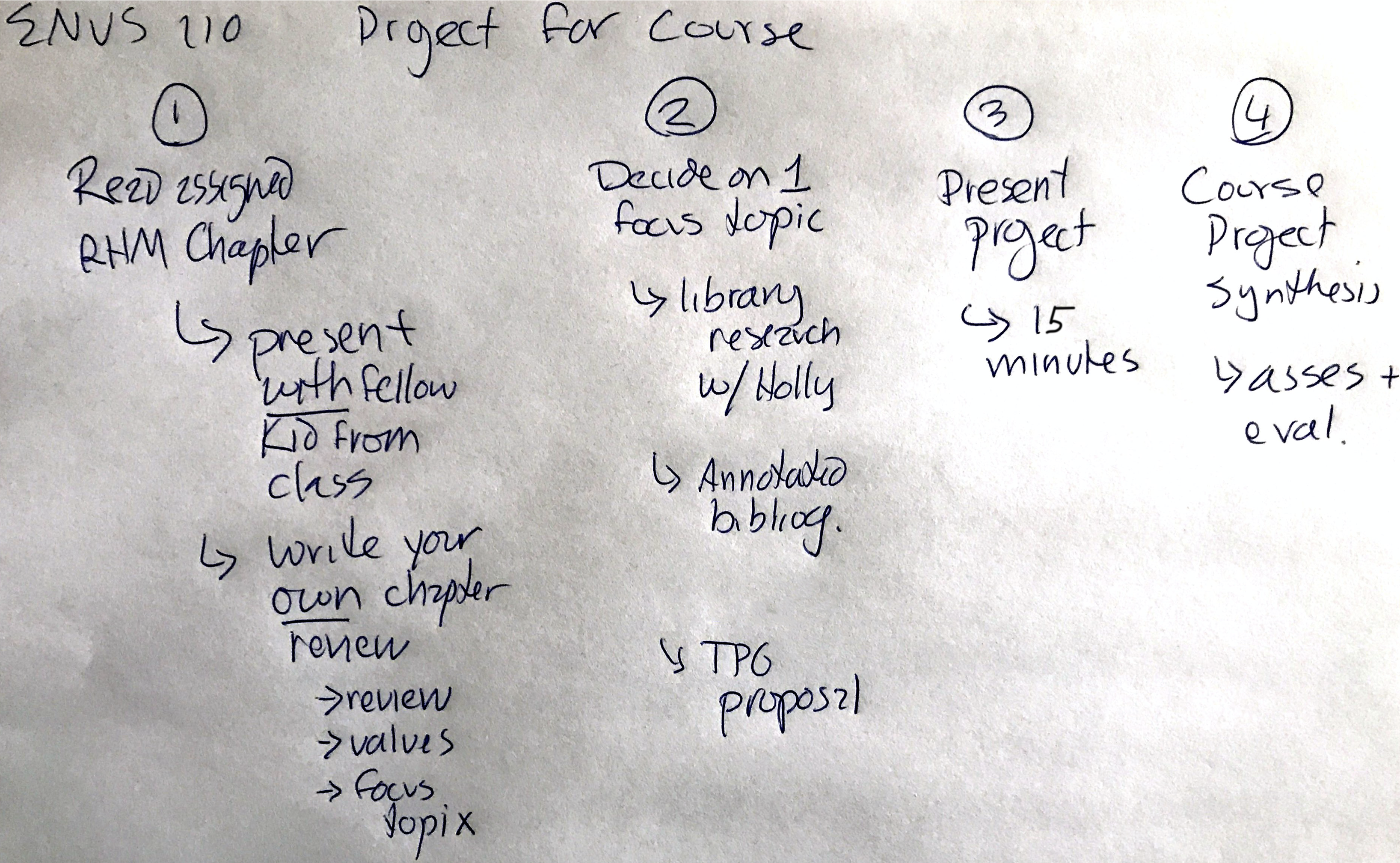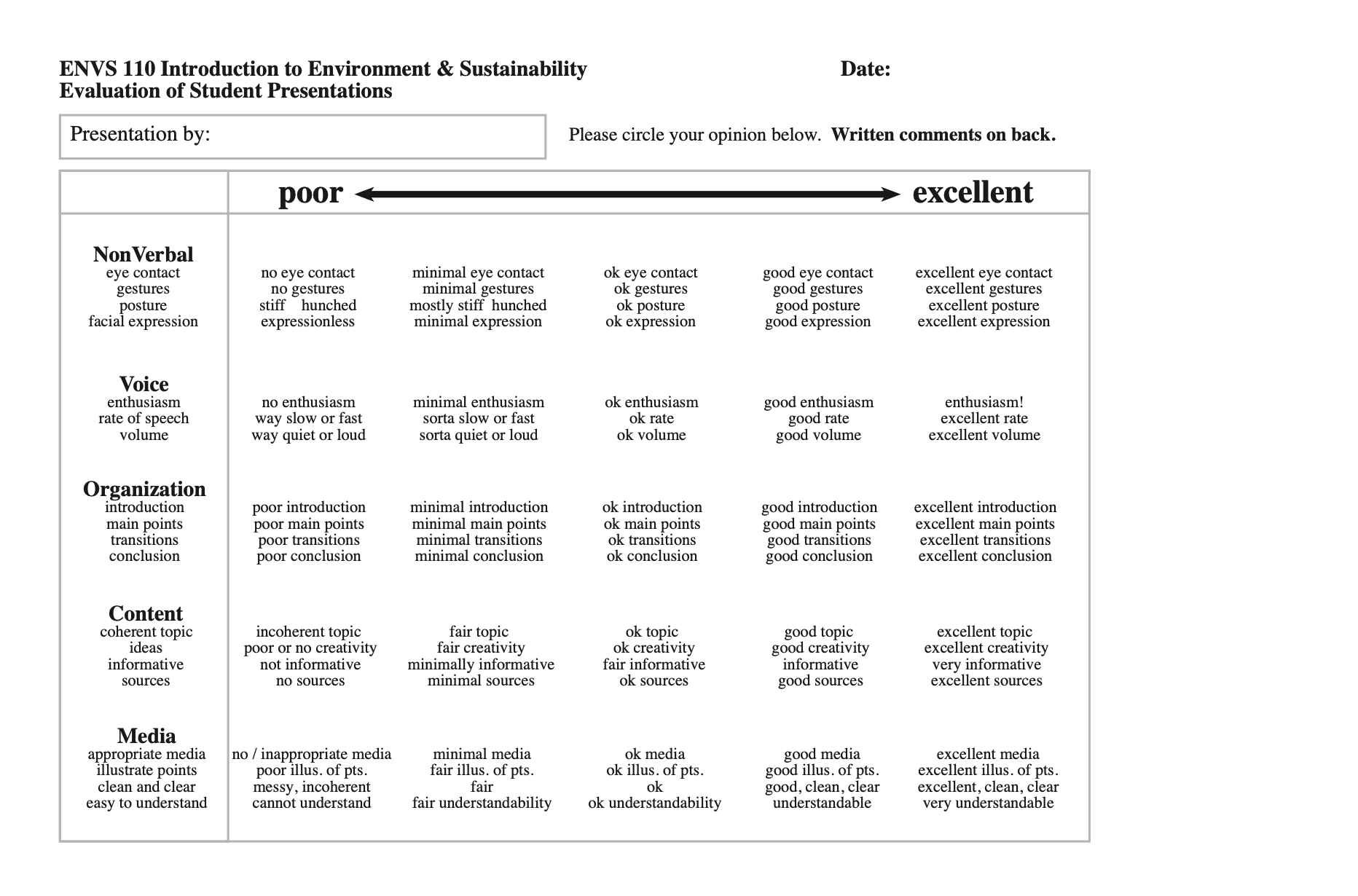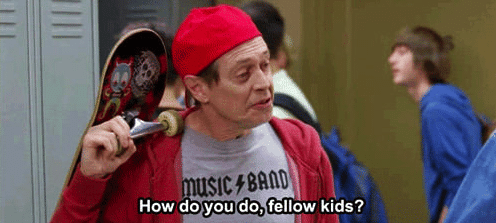Updates 5/27/2025
Office Hours: Make an appointment here or email for other times

The project entails four delightful steps:
- Chapter Review + Values + Focus Topics: Begin with one chapter (9-17) from our course text: RHM: Paul Robbins, John Hintz, and Sarah A. Moore, Environment & Society: A Critical Introduction (3rd edition). Write a 6-page review of the chapter. Identify your personal environmental values and use those to select three particular topics of interest from the RHM chapter you reviewed. (Go to Details below)
- Focus Topic + Annotated Bibliography + TPG Proposal: Select one of your three focus topics. Locate at least two relevant books, two relevant articles, and two relevant WWW sources on the topic. Write a 250-300 word review of each of your sources. Based on your environmental values, general reading (the chapter), and your specific resources, develop a 3-page TPG proposal that could be implemented (in the future, outside of this class), putting your values into practice solving an environmental problem. (Go to Details below)
- Presentation: Present your work to the class at the end of the semester. (Go to Details below)
- Course Project Synthesis: Combine your revised chapter review (already complete) with your Annotated Bibliography (with minor revisions if needed), Specific Project Proposal, a link to your presentation or presentation notes, and assess the entire project and what you learned (Go to Details below)
-
Conscientiousness is the most important attribute of successful college students and is also important in the workplace (more info).
- “Conscientiousness implies a desire to do a task well, and to take obligations seriously. Conscientious people tend to be efficient and organized. They exhibit a tendency to show self-discipline, act dutifully, and aim for achievement; they display planned rather than spontaneous behavior, and they are generally dependable.”

Subscribe to ENVS 110 Calendar:
- On your computer, open Google Calendar.
- On the left, next to “Other calendars,” click Add
Subscribe to calendar.
- Copy & paste this address in the Add calendar field, where prompted:
owu.edu_pgg3cf6e7s9tj6evcbnc69lfk0@group.calendar.google.com
- Press Enter. The calendar will appear on the left side under “Other calendars” as ENVS 110 Intro to E&S
Subscribe to the OWU Academic Calendar
- On your computer, open Google Calendar.
- On the left, next to “Other calendars,” click Add
Subscribe to calendar.
- Copy & paste this address in the Add calendar field, where prompted:
owu.edu_vl2d8chfrg995vsn2rjnossosg@group.calendar.google.com
- Press Enter. The calendar will appear on the left side under “Other calendars” as Academic Calendar – OWU.
Sharing your work with Instructor: this is how you turn stuff in
- Go to your OWU Drive account
- Create a new folder with the course and your last name
- +New button (upper left) >> then Folder
- Robert Smith’s folder would be: ENVS 110 Smith
- Share that folder with me (so I can edit)
When you are ready to turn in your work: for example, the 6-page chapter review
- put the document in the shared folder
- email me that your document is in the shared folder and ready for me to review
Formatting Shared Class Documents:
- Google Docs only. No PDFs, Word, WriteNow, Wordstar, Shtppr, 2f98 f3r, or other documents
- Give me full editing permission for your docs. I need this for grading.
- If you do revisions, please use the same file. I need to be able to look back at the revision history.
- Give the docs a logical name (Chapter Review, Annotated Bibliography, etc.)
- Formatting of pages
- default margins
- default font
- line spacing = 1.5
- font size = 11
Resources for course and project:
- ENVS 110 Course Project Library Resources
- ENVS 110 Library/Research Forms
- OWU Library Services and Access Guide
- Holly Birk, Public Services & Science Librarian (hebirk@owu.edu): Research help for students: Email for an appointment.
- OWU Connection Grants
Additional Resources:
- OWU Sagan ARC Writing Center
- Digital Submissions Guide
- Assessing Your Environmental Values
- Transferable Skills
Chapter Review + Values + Focus Topics
- Write a personal review of one RHM chapter from 11-19, focusing on the key issues, debates, and controversies surrounding the topic.
- Present the content of your chapter together with one or two of your fellow kids in the class.
You will be inverse randomly assigned a chapter, which you will read and review by yourself, and present with a few fellow kids in the class
Assigned chapters and students: Section 1 MWF @ 9 AM – 9:50 AM
| Name | RHM CH |
| 11. Carbon Dioxide | |
| 11. Carbon Dioxide | |
| 11. Carbon Dioxide | |
| 12. Trees | |
| 12. Trees | |
| 12. Trees | |
| 12. Trees | |
| 13. Wolves | |
| 13. Wolves | |
| 13. Wolves | |
| 13. Wolves | |
| 14. Uranium | |
| 14. Uranium | |
| 14. Uranium | |
| 14. Uranium | |
| 15. Tuna | |
| 15. Tuna | |
| 15. Tuna | |
| 16. Lawns | |
| 16. Lawns | |
| 16. Lawns | |
| 16. Lawns | |
| 17. Bottled Water | |
| 17. Bottled Water | |
| 17. Bottled Water | |
| 17. Bottled Water | |
| 18. French Fries | |
| 18. French Fries | |
| 18. French Fries | |
| 18. French Fries | |
| 19. E-Waste | |
| 19. E-Waste | |
| 19. E-Waste |
Assigned chapters and students: Section 2 MWF @ 11 AM – 11:50 AM
| Name | RHM CH |
| 11. Carbon Dioxide | |
| 11. Carbon Dioxide | |
| 11. Carbon Dioxide | |
| 12. Trees | |
| 12. Trees | |
| 12. Trees | |
| 12. Trees | |
| 13. Wolves | |
| 13. Wolves | |
| 13. Wolves | |
| 13. Wolves | |
| 14. Uranium | |
| 14. Uranium | |
| 14. Uranium | |
| 14. Uranium | |
| 15. Tuna | |
| 15. Tuna | |
| 15. Tuna | |
| 16. Lawns | |
| 16. Lawns | |
| 16. Lawns | |
| 16. Lawns | |
| 17. Bottled Water | |
| 17. Bottled Water | |
| 17. Bottled Water | |
| 17. Bottled Water | |
| 18. French Fries | |
| 18. French Fries | |
| 18. French Fries | |
| 18. French Fries | |
| 19. E-Waste | |
| 19. E-Waste | |
| 19. E-Waste |
- Write a personal review of one RHM chapter from 9-17, focusing on the key issues, debates, and controversies surrounding the topic.
For your personal chapter review: Assume you are writing a report on the chapter topic that will be presented to interested non-experts. Thus you need to clearly and coherently present the topic to your reader. This review should be 6 pages long (see formatting suggestions, above). RHM “Objects of Interest” chapters (latter half of book) in part depend on content in the first half of the book (“Approaches and Perspectives), which we will be working through in lectures. Thus there may be some concepts you run into that we have not yet discussed in class. No biggie. Look it up!
Suggested format of Chapter Review + Values + Focus Topics:
- Include your name and indicate that the following book is the source of your review: Paul Robbins, John Hintz, and Sarah A. Moore, Environment & Society: A Critical Introduction (3rd edition). Wiley/Blackwell 2022. Indicate the name of your chapter. Cite any other sources you use.
- 1 page: Summarize the chapter: Note key concepts and issues related to the environmental “object” your chapter reviews. Summarize the big perspectives (from the initial chapters in the book) that will be used to shed light on the chapter topic.
- 3 pages: Your “object” and the big perspectives: Develop the key aspects of your chapter “object” in more detail, and relate how the big perspectives (first half of the book) are used as a lens to understand key aspects of the object and it’s environmental and social context. End with an assessment of what you think are the major takeaways from the chapter.
- 1 page: Assessment of your personal environmental values. See Assessing Your Environmental Values.
- 1 page: Three Focus Topics: The last part of your chapter review should be three project ideas you could develop into a TPG grant. These can come from your chapter, but don’t have to. Each should have the potential as a practical project. That practical project could happen on campus, on the other side of the world, focus on research, a practical application, an internship, etc. For example, if you review the Lawns chapter, you might end up with a project proposal to investigate ways to reduce lawn chemicals at OWU, study (with a TPG grant) the impact of lawn chemicals on bees, or seek an internship with a firm (possibly with alumni connections) developing alternatives to chemical lawn care, or design a project to promote and educate homeowners about the impact of lawn chemicals. You may develop a project idea based on your own interests, career goals, research and internship opportunities, and so on.
- We’ve already discussed ideas in class. It’s fine if you focus on one of the ideas and briefly mention the other two.
2. Present the content of your chapter together with one or two of your fellow kids in the class.
Check the course schedule for the day you are scheduled to present your chapter. Coordinate with your fellow kids.
Put together a presentation: Go to the schedule and find the page for your chapter: click on it and find resources (slides and links) to use for your presentation. To modify the slides: File >> Download >> Microsoft Powerpoint. You can immediately upload the .ppt file to Google Slides in your ENVS 110 folder. Modify the slides there and use them for your presentation.
Revisions to Chapter Review: You may revise your chapter review for a better grade. Please revise the original document so I can review your suggestions and changes. If you get help with the revisions from the Writing Center, have them work on the original document. Google Docs tracks all changes, allowing me to see what you revised.
Revisions of RHM Chapter Review:
- Please contact the OWU Writing Center for an appointment if I ask you to revise the chapter. This is a chance to get a much better grade. Take advantage of it.
Focus Topic + Annotated Bibliography + TPG Proposal
Focus Topic
At the end of your chapter review, you defined three topics of interest. Select one of the three topics as your focus topic. Think about a practical project you could engage in in the context of your focus topic. It can be on campus, linked to a semester abroad, or an internship focused on lab research, or whatever you want. Anything goes.
Make sure you have searched for books, peer-reviewed articles, and other sources (such as official reports, etc.). In the end, select the six sources among those you find that are most relevant to your project. Share those six with Holly Birk and Krygier, and when approved, use them for your annotated bibliography.
Help locating relevant sources will be provided by your instructor and the science librarian at OWU. It is important that you learn how to locate resources from a diversity of sources, and that you learn how to assess the quality and relevance of these resources. Class time will be spent assisting you in both of these endeavors. You will also schedule an independent meeting with science librarian Holly Birk.
- ENVS 110 Course Project Library Resources: reference, books, articles, and web resources
It is vital that you determine the best sources for learning more about your focus topic, then seek those sources wherever they may be. Do not select sources only because they are easy to find (full-text articles on the WWW or a book that just happens to be on the shelf at Beeghly). You may have to order an article through interlibrary loan or get a book from another campus. It may take weeks for such sources to get to you at OWU – thus you cannot wait until the last minute to get sources.
Suggested format of Annotated Bibliography: Six pages total
- One page: Introductory material
- 1/2 page: description of your project focus topic
- 1/2 page: comment on your process for finding your sources: problems, how you solved them, role of librarian or instructor in the process, use of interlibrary loan, any shifts or changes in your focus topic as you found resources.
- Five pages: Six annotated bibliography entries: about 250-300 words per source (book sources may be slightly longer).
Annotated Bibliography Entry Format
An annotation is a summary and/or evaluation. For each of your sources include the following (source): Please number the four sections of each of your annotated bibliography entries to help your instructor:
- The source with an appropriate citation style. Many of the library resources you used to find your sources include the ability to export your source in a particular citation style. Pick one and try to stick to it. Information on citation styles.
- Summarize: What are the main arguments? What is the point of this book or article? What topics are covered? If someone asked what this article/book is about, what would you say? The length of your annotations will determine how detailed your summary is. For more help, see paraphrasing sources.
- Assess: After summarizing a source, evaluate it. Is it a useful source? How does it compare with other sources in your bibliography? Is the information reliable? Is this source biased or objective? What is the goal of this source? For more help, see evaluating resources.
- Reflect: Once you’ve summarized and assessed a source, ask how it fits into your research project. Was this source helpful to you? How does it help you shape your argument? How can you use this source in your research project? Has it changed how you think about your topic?
Examples of an annotated bibliography entry:
1. Bukhary, S., Ahmad, S., & Batista, J. (2018). Analyzing land and water requirements for solar deployment in the Southwestern United States. Renewable and Sustainable Energy Reviews, 82, 3288-3305. doi:10.1016/J.RSER.2017.10.016
2. This article focuses on the land and water requirements for solar energy development in the Southwestern United States. This article highlights the fact that both CSP and solar photovoltaic (PV) have benefited from new technology which reduces the cost of these systems. However, it also highlights the fact that both forms of solar energy require large amounts of water for initial development as well as for sustained use. This is a potential problem for certain areas in the world, like the Southwestern United States. Although they have abundant solar potential, the lack of water may be a huge shortcoming. The study gathered data about land and water use and analyzed it in order to better understand how much and of what kind of solar energy was feasible. The results generated a model that can be used to judge if an area has suitable land and water requirements.
3. This article is reliable and was published within a review on renewable and sustainable energy. The authors are clearly invested in the scientific method and in discovering more about solar energy generation. This source is useful because it is discussing the land use requirements as well as looking at the ways in which we can potentially deal with them.
4. This source fits with my project because it directly addresses my questions about land use requirements and developed a scientific method for evaluating other areas’ potential land. The source also presented me with the issue of water as a requirement for solar energy. This is something that I hadn’t been exposed to before. Learning that water is a potential requirement for solar energy generation is very important to my project and is something that I will need to include within my report.
A few environmentally-themed annotated bibliographies:
- Advancing Environmental Justice: Annotated Bibliography
- Annotated Bibliography: Environmental Education (1998-2013)
- Development, Climate, and Environment: An Annotated Bibliography
Details about citation style and writing an annotated bibliography will be presented in class.
TPG Proposal
Based on your environmental values, general reading (the chapter), and specific resources, develop a 3-page TPG proposal that could be implemented, putting your values into practice.
You are not required to submit this proposal nor pursue the topic beyond this course. Unless you want to! The point is to learn about OWU’s fabulous OWU Connection Grants program and the nuts and bolts of developing a proposal.
There are two different grant programs: The OWU Connection Grant (up to $4000) and the Theory into Practice Grant (more than $4000).
- OWU Connection Grant: 2024-25 deadlines Thursday, September 26, Thursday, November 28, Thursday, February 20, Wednesday, April 16
- OWU TPG Grant: 2024-25 deadlines: Tuesday, October 1, March 1
- For a real TPG: set up an appointment with a student mentor for these grants or stop by the IOCP office in Slocum 311 anytime between 9-4, M-F.
For this course, we will follow the format of the TPG grant even if your funding request is less than $4000.
Overview of TPG Format (how to structure your TPG)
Evaluation & Expectations (Rubric, IRB, etc.)
A few more bits:
Research with Indigenous People or Communities: Please read the material on this page if your proposal includes work with communities, particularly Indigenous communities.
Citations: Grant proposals can contain citations if you use a quote or want to refer to a source as an essential foundation for your proposed project. Citing important sources also makes the proposal look academically sound and professional.
Budget: Because this is a draft of a real TPG, you can speculate a bit more than you would in a real TPG.. The point here is to understand what you need to do when you pursue an actual TPG grant.
Presentation of Course Projects

Each student should prepare a 12-minute presentation (with a minute for setup and a minute or three for questions at the end).
Please put a set of Google slides in your class folder, shared with your instructor.
- Title with date and your name
- Overview of your specific topic and the scholarly context (Annotated Bibliography)
- Project Objectives (from TPG)
- Evaluation, Assessment, and Sharing (from TPG)
- Personal Statement – Why you are interested in this topic / project
- Budget
- Conclusions (if you have any; at least a “The End” slide
Pro-tips:
- Don’t include videos unless they are videos you made yourself, as this is substituting someone else’s presentation for your presentation.
- Talk through your presentation once or twice. If you are unsure how to pronounce a word, look up the pronunciation.
- Don’t waste time getting your presentation going: Please check that your slides work and have them ready to go before your presentation starts.
- More information on how to organize and present material is available on the course Presentation Skills page.
Non-presenters: Please think up two questions for each presenter. Write it on the back of the presentation evaluation form (below).

Course Project Synthesis

You are not required to write a final paper for your course project. Instead, consider your Presentation and a Project Synthesis as the final products. The Project Synthesis (see Course Schedule for due date) consists of a single document (saved in the shared class folder) with all this stuff in it:
- An assessment of your entire project and what you learned (new stuff)
- Your Chapter Review (already completed)
- Your Annotated Bibliography (already completed)
- Your Specific Project Proposal (already completed)
- A link to your presentation (already completed, and saved in the shared class folder)
Please include appropriate headers for each section above.
Assessment: About 3 pages
- 1 page: Discuss what you have learned about your topic and the research process leading to your TPG. Refer to the chapter review and presentations, library research skills, annotated bibliography, and specific project proposal and presentation. This is the scientific research process. It’s not simple, but it’s essential to environmental work.
- Comment on the process of the project – was the way we engaged it, step by step, over the entire semester helpful? What was the most useful thing you learned?
- Students often think the project (the research process, in this course, leading to a TPG) is complicated and confusing. I admit, it’s a challenge! Do you have suggestions as to how I could make the process less complicated and confusing?
- 1/2 page: Conscientiousness turns out to be the most important attribute of successful college students and is also important in the workplace (more info).
- “Conscientiousness implies a desire to do a task well, and to take obligations seriously. Conscientious people tend to be efficient and organized. They exhibit a tendency to show self-discipline, act dutifully, and aim for achievement; they display planned rather than spontaneous behavior; and they are generally dependable.”
- ENVS 110 contains a complex (and thus realistic) research project with many steps, lots of due dates, and revisions; it might just be set up to assess your conscientiousness, which is vital to success in college and life. Thus, assess your conscientiousness in this class, how it could improve (in general) for you, and if you think it is important to succeed in college and your career.
- 1/2 page: You now have a draft TPG. Super! Do you think you might work on it and submit it? I’m happy to aid in that process after the semester ends. Or maybe you have a different topic you’d like to develop into a TPG. If you don’t think you would ever submit a TPG, let me know why: what are the impediments?
- 1/2 page: Review the Transferable Skills page, and comment on five skills learned in the course
- 1/2 page: What do you think you should get for a grade on the course project and why. Please note the grade you got on the Chapter Review and the Annotated Bibliography/Specific Project Proposal and compare the quality of your Presentation to other student presentations in the course. Please note any changes you have made to the project that may support a higher grade than you were originally given. Take into account your ability to get work in on time (or not!). Please justify the grade you think you deserve.
Your final grade for the course project consists of:
- 100 pts: Chapter Review & Presentation
- 100 pts: Sources and Annotated Bibliography
- 100 pts: Project Proposal & Presentation
- 100 pts: Project Synthesis & Attendance & Improvement & Keywords
Keywords: Miss some keywords? Let me know, I can send you what you’ve submitted, then submit missing keywords for some credit. Please let me know in a note at the start of the Project Synthesis that you have completed the keywords.


